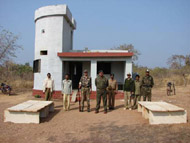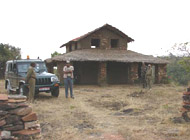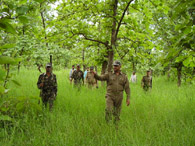![]()
Threats
Those arising out of need. These are :
collection
of fuel wood for bonafide domestic use;
collection
of M.F.P. for use of villagers themselves
unemployment
and under-employment, coupled with general poverty, drag people to forest;
tradition
of cattle rearing villagers cannot say absolute NO to cattle and
they do not know stall feeding
enclaved
habitations people have been there for centuries.
Those arising out of greed. These are:
timber
theft for sale;
forest fire beliefs that summer season forest fire produces better quality grasses, removes some of bad omens, cures illnesses, etc;
least
concern for wild animals they are game, meant for shooting, recreation
and poaching;
lack of awareness environmental, moral scientific;
practice
of keeping large hers of cattle (called dhan)
with no responsibility as to feed them forests have pastures;
A
third category of problems is purely management related and concerns PAs
in particular:
crop
depredation by wild animals;
water
scarcity in summers;
question
of enhancing the population of carnivores and herbivores and then arriving at
a balance;
there are
numerous old pedestrian paths and short routes to various places within and
across the park;
lack of
nature education among masses in general;
disoriented
staff
![]()
The
estimation is coming to more realistic figures as a result of refinement in
census techniques over the years. This has been made possible by training of the
field staff in census methodology and with their experience of working in the
typical terrain.
All India Tiger Monitoring exercise undertaken on the direction of the Ministry of Environment an Forests by the Wildlife Institute of India in association with National Tiger Conservation Authority, MOEF, Government of India, and the State Forest Departments.
The current monitoring system for tigers. co-predators, prey and their habitat transcends beyond generating mere numbers. It is a holistic approach which uses the tiger as an umbrella species to monitor some of the major components of forest systems where the tiger occurs in India.
Panna landscape covers an area of 3500 km2 and has 2 discrete tiger occupied areas of 787 km2 and 187 km2. The larger population of Panna Tiger Reserve and its surrounds sustains 24 (+ 1 se range 15-32) tigers. The smaller population is relict comprising of 1-2 tigers likely sustained by north eastern dispersal of tigers from Panna.
![]()
This is one of the most injurious elements for the depletion of forests. Fires are common all over in summer. They start in the month of January and continue till the first monsoon shower i.e. early June in this tract. However, in the months of April and May when the temperature goes very high and the humidity is very low, incidences of fire are at their peak. The forests are dry deciduous and therefore the fires are mostly surface fires - the fire burns leaves, twigs and other fuels on forest floor. Majority of the fires are man made. They are generally caused by the negligence of the passers by.
Regular maintenance of fire lines, early detection and control of wild fires and
compulsory reporting of fire cases are some of the important steps taken to
bring down the net area burnt every year and net reduction in habitat damage
from fires. In the process the density of vegetation has improved over the
years. Grasses have become more palatable. Fruit bearing trees and shrubs have
also grown adequately. Herbivores are sighted easily both in the interior as
also on the periphery of the park.
 |
 |
|
Fire watch tower |
Fire Monitoring Hut |
|
|
|
|
Round the clock watch |
|
In recognition therefore, WWF Tiger Conservation Programme-India awarded a certificate of merit and a cash award of Rs. 50,000/- to Panna Tiger Reserve for saving the forest from fire in 1999.
![]()
Most
wild animals will only stay in a given area if there is water, and for this
reason it is called a "limiting resource" because it can limit the
number of animals. In
the dry deciduous area water is a precious resource for wildlife. Areas within
the park that are presently inhabited by people have some perennial source of
water.
The Ken river in whose catchment the national park is situated, is a major tributary of the Yamuna. Although the water reduces in the river during summer but it is never completely dry. The springs along the escarpments are perennial and are fed by aquifers draining into crevices along the escarpments. The monsoon rains are the only source of water for a large part of the park.
Development
of water sources is being done through the construction of check dams and
contour trenching so that water is available in the lean period. Creation and
deepening of water holes is also done is suitable areas on a year to year basis.
Water
regime is showing signs of improvement as water stays longer in water holes
mainly as a result of soil and water conservation works.
Water as a lifeline for the animals in Panna Tiger Reserve
![]()
Ecodevelopment programme was
started in Panna National Park in 1995. Till now, 14 E.D.Cs have been formed and
by virtue of that better coordination between staff and people have been
achieved. Fourteen forest ecodevelopment committees have been
formed around the park with the initiative of the park management. Of these nine
committees were taken up under the M.P. Forestry Project for Ecodevelopment. The
other are being strengthen from other sources locally.
![]()
Of the 13 villages situated in the National Park, the proposal to shift 8 3 villages got approved by Govt. of India. Out of the 8 villages namely, Pipartola, Surajpura and Mota Chowkan have been successfully relocated with the consent of villagers in the year 2007.
![]()
|
S.No |
Post |
No. |
|
| 1. | Conservator of
forests (WL) & Field Director |
01 |
 |
| 2. | Deputy Director |
01 |
|
| 3 | Veterinarian |
01 |
|
| 4 | Asst. Director |
02 |
|
| 5 | Range Officer |
06 |
|
| 6 | Deputy Ranger |
03 |
|
| 7 | Game Supervisor |
10 |
|
| 8 | Game Guard |
60 |
 |
| 9 | Barrier checking Guard |
08 |
We Love Our Panna Tigers and Panna People
|
|
|
| Home| The
Park | Biodiversity | The
Management | Research | |